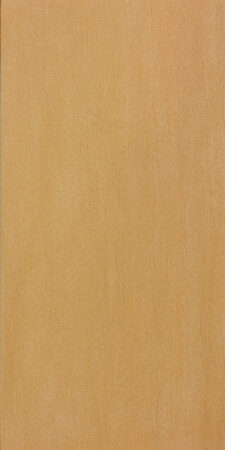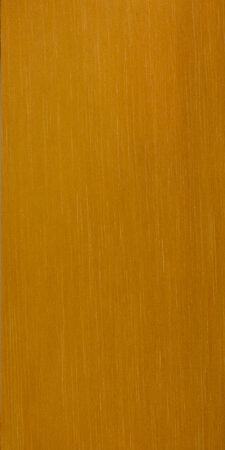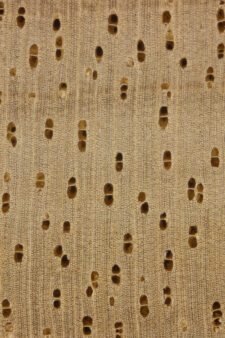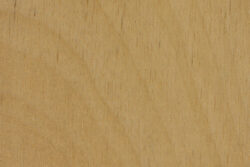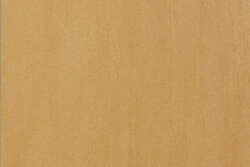Common Name(s): Siam balsa, hard milkwood, pulai
Scientific Name: Alstonia spatulata
Distribution: Southeast Asia and Pacific Islands
Tree Size: 32-65 ft (10-20 m) tall,
1-2 ft (.3-.6 m) trunk diameter
Average Dried Weight: 25.0 lbs/ft3 (400 kg/m3)*
Specific Gravity (Basic, 12% MC): .34, .40
Janka Hardness: 450 lbf (2,000 N)*
Modulus of Rupture: 7,330 lbf/in2 (50.6 MPa)
Elastic Modulus: 1,039,000 lbf/in2 (7.17 GPa)
Crushing Strength: 4,470 lbf/in2 (30.8 MPa)
Shrinkage: Radial: ~3%, Tangential: ~6%,
Volumetric: ~9%, T/R Ratio: ~2
*Root wood of this species has an average dried weight of 3.6 lbs/ft3 (60 kg/m3) and an estimated hardness of only 8 lbf (36 N).
Color/Appearance: Heartwood is light to golden brown, not clearly demarcated from the sapwood. Intermittent latex canals are sometimes present and appear as slits in the wood. The wood can also be susceptible to fungal staining if not dried properly.
Grain/Texture: Grain is usually straight or slightly interlocked. With a fine to medium texture and low natural luster.
Rot Resistance: Rated as perishable; poor insect resistance.
Workability: Easy to work with both hand and machine tools. Poor bending properties. Turns, glues, and finishes well.
Odor: Can have a strong unpleasant odor when green, diminishing somewhat in dry wood.
Allergies/Toxicity: Although there have been no reports of health reactions with Siam balsa, other closely related species in the Alstonia genus have been reported to cause skin irritation—possibly in conjunction with the latex canals found in the trunk. See the articles Wood Allergies and Toxicity and Wood Dust Safety for more information.
Pricing/Availability: Most pulai that’s used commercially is harvested from South and Southeast Asia. The lighter root wood is sometimes recovered as driftwood and used domestically on a limited basis. Prices are low within its natural range.
Sustainability: This wood species is not listed in the CITES Appendices, and is reported by the IUCN as being a species of least concern.
Common Uses: Utility wood, plywood, carvings, crates, and boxes. The lighter root wood is used as a substitute for cork, as well as rafts and pith helmets.
Comments: The regular trunk wood of Alstonia spatulata is very closely related to Indian pulai (Alstonia scholaris) and is also sold under the trade name pulai (or alternatively, as hard milkwood—so named for the milk-like latex that is exuded from the tree).
However, the root wood of the tree bears extremely soft and lightweight wood that’s been compared to styrofoam. The root wood is so soft that it is still scientifically unexplained as to how such material could bear up an entire tree. One hypothesis is that the trees are simply not very strong, and easily storm damaged, which may help explain the predominance of large chunks of the buoyant trunk recovered as driftwood in the Central Pacific.
Despite its common name, Siam balsa is not closely related to true balsa (Ochroma pyramidale).
Images: Drag the slider up/down to toggle between raw and finished wood.
There are currently no pictures of this exact wood species, but a similar species within the Alstonia genus is being substituted (A. scholaris). If you’d like to contribute a wood sample for this webpage, please see the contact form for donating wood samples.
Identification: See the article on Hardwood Anatomy for definitions of endgrain features.
Porosity: diffuse porous
Arrangement: primarily radial multiples of two to five pores
Vessels: large, few to very few
Parenchyma: banded (possibly marginal), and reticulate
Rays: narrow; normal spacing
Lookalikes/Substitutes: Superficially, pulai is very similar to the CITES-restricted, Southeast Asian hardwood ramin (Gonystylus spp.)—although ramin tends to be significantly heavier (655 kg/m3 vs 410 kg/m3), with winged parenchyma, and lacking the radial multiples commonly seen in Alstonia spp.
Jelutong (Dyera costulata) is another Southeast Asian native that has similar weight, appearance, and anatomy. In fact, the two species are botanically related—both are in the dogbane (Apocynaceae) family. The two can be difficult to separate, but jelutong tends to have more consistent parenchyma banding, forming a reticulate pattern with the rays.
Notes: None.
Related Content:

